The epic Sahara Desert is known for its dusty dunes and record-breaking temperatures, but did you know around 70% of the Sahara is mountainous, plateaued, or rocky, and its landmass is comparable to the United States? There’s also more water than you might think. This means an incredible array of animals live there. The Sahara desert is home to over 70 mammals and 100 reptiles, but let’s take a look at the most dangerous animals lurking in the Sahara desert.
The Sahara Desert’s Most Dangerous Animals
As well as extreme daytime heat, freezing night temperatures, violent, destructive sandstorms, and dehydration from lack of water, these animals can potentially kill a human.
1. Spotted Hyena
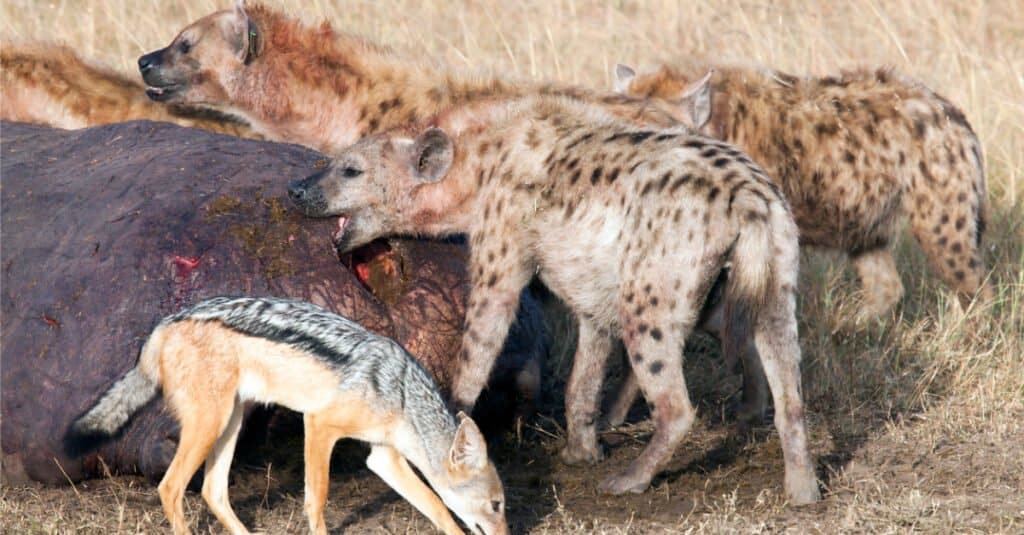
Spotted hyenas hunt in packs and reach 37 mph.
©iStock.com/Angelika
Carnivorous spotted hyenas are known for their unflattering role in The Lion King, but are they dangerous?
They’re certainly capable of hunting humans!
Hyenas have sharp teeth in their powerful jaws that are strong enough to chomp through bone. While they generally don’t threaten humans, they will lash out if threatened, competing for food or protecting their pups.
Hyenas scavenge, taking kills from top predators like cheetahs, and they hunt injured, young or old animals. Their main prey includes birds, snakes, wildebeest, and even insects. They hunt in packs and run at 37 mph, which is more than enough to catch a fleeing human. Alongside their speedy sprints, hyenas display incredible endurance.
There are four different species of hyena, but the largest is the spotted hyena that lives on the fringes of the Sahara desert. Matriarchs lead hyena packs, and females grow larger than males. A fully grown female spotted hyena can reach 6.5 feet long!
2. Horned Viper
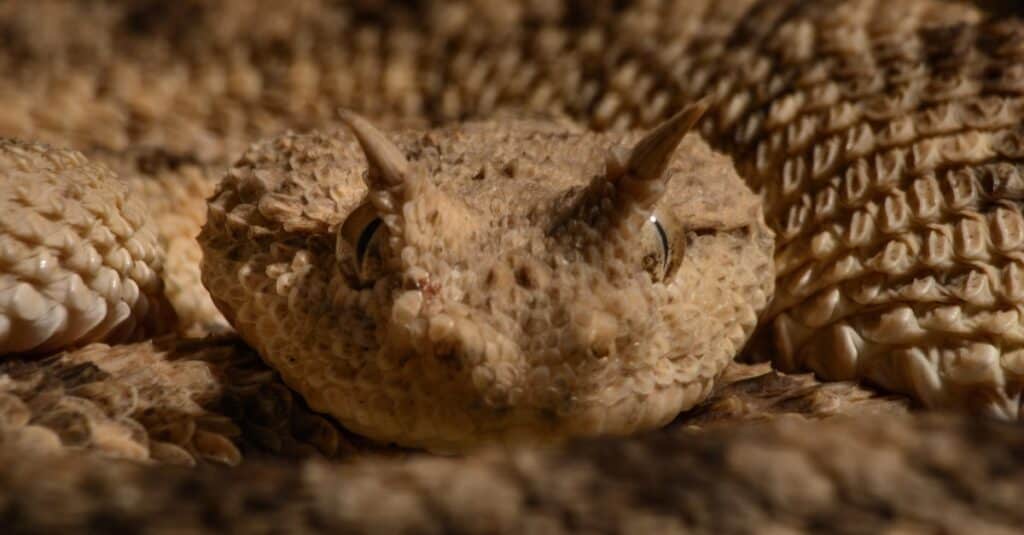
Horned vipers use sidewinding movements to ascend sand dunes.
©iStock.com/rippinlines
The Sahara desert is home to several venomous snake species. The horned viper Cerastes cerastes is one of the most dangerous.
This deadly two-foot-long snake displays distinctive supraocular horns over each eye, although some individuals don’t have them. Female horned vipers reach longer lengths than males, but they’re equally dangerous.
Chiefly yellow with gray, brown, and rectangular dark shapes running the length of its body, this epic viper blends seamlessly with the Saharan sands and rocky outcrops. Prey consists of rodents, geckos, small lizards, and birds caught with a swift strike and held until the venom takes effect.
Horned vipers travel long distances to search out prey, moving in a distinctive sidewinding fashion that helps them climb dunes and leaves imprints in the sand.
When threatened, this snake coils its body and rubs its scales together, producing a rasping sound. Horned viper venom is enough to kill a human, and stories suggest ancient Egyptian Cleopatra used this snake to end her life. Several horned viper mummies have been unearthed on the Nile‘s banks!
3. Sand Viper

Sand vipers hide in the sand to ambush passing prey.
©reptiles4all/Shutterstock.com
Sticking with dangerous vibes, the 20-inch-long sand viper is another dangerous animal in the Sahara desert and certainly not one you’d want to step on. Its venom is strong enough to kill humans, but this is a rare event. However, to make things worse, this snake buries its body in the sand to control its temperature and strike unsuspecting prey.
A close relative of the horned viper above, this sidewinding snake’s venom kills rodents, lizards, and geckos almost immediately.
4. African Wild Dogs
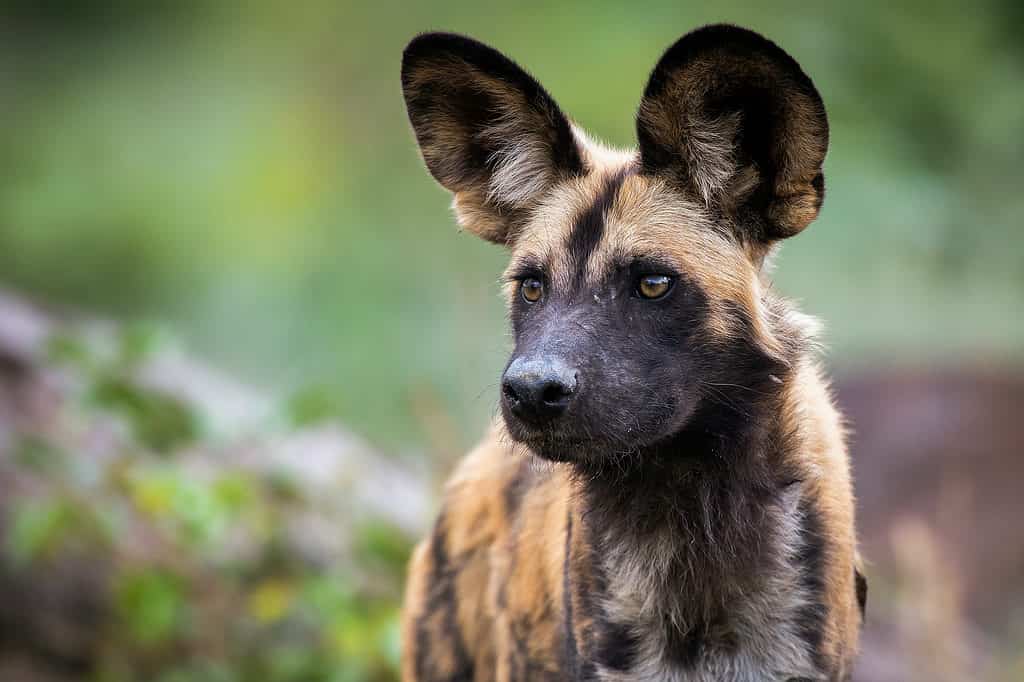
Endangered wild dogs face persecution from farmers and habitat encroachment.
©Richard Juilliart/Shutterstock.com
Wild dogs, also called painted dogs, have distinctive large rounded ears, long legs, and unique yellow, red, black, brown, and white fur patterns with a white-tipped tail.
These remarkable canines are highly social pack animals that roam the Sahara desert in search of water and gazelle prey. Like wolves, wild dogs are intelligent and capable of hunting large animals. They’re not usually a problem for humans, but if a pack decides to hunt one, it’s a dangerous situation to be in.
However, African wild dogs are at much more risk of harm from humans. This epic dog is endangered due to persecution and habitat loss. Currently, only 6,600 exist in the wild.
5. Saharan Cheetah

Conservation efforts have raised Saharan cheetah numbers in the last ten years.
©Stu Porter/Shutterstock.com
The Saharan cheetah is a subspecies of cheetah native to the Sahara and Sahel deserts. It’s often called the Northwest African cheetah, but it’s extinct in more than 20 countries.
We almost lost this elusive cheetah in 2008 when only 250 individuals survived in the wild. Today, thanks to conservation efforts, around 8,000 live in the mountainous Saharan desert areas and near oases where they prey on animals searching out water. Despite this incredible increase, Saharan cheetahs are still critically endangered.
By far, this cheetah is the fastest animal in the Saharan desert. It can reach 75 mph, more than enough to outrun Usain Bolt and certainly enough to catch its springbok and gazelle prey.
6. Deathstalker Scorpion

The deathstalker
scorpion
is the most dangerous scorpion on Earth.
©Bens_Hikes/Shutterstock.com
The most dramatically named dangerous animal in the Sahara desert is the deathstalker scorpion, and it gets this epic name for good reason!
This is the most deadly scorpion in the world. Its lethal cocktail of neurotoxins is excruciating and can be fatal for children, the elderly, or the sick. Thankfully, fatalities are rare.
Scorpions emerge from cozy burrows at night to avoid the scorching Saharan heat and hunt down spiders, centipedes, termites, ants, beetles, and other scorpions. With a single sting, four-inch-long deathstalker scorpions paralyze prey, then chew off small sections at leisure.
7. Black Widow Spider
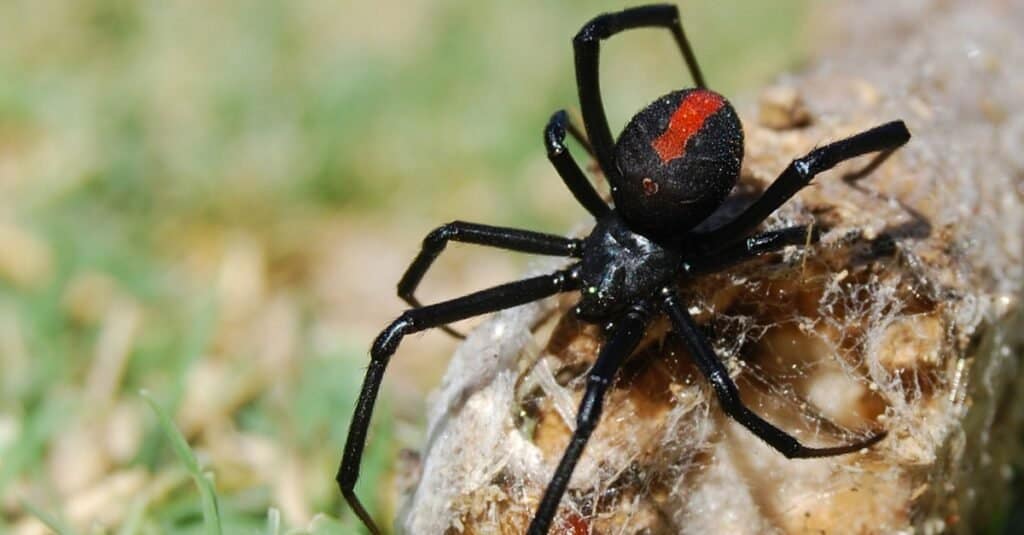
Black widow spider bites produce week-long pain, vomiting, and muscle rigidity symptoms.
©iStock.com/maria72
We’ve all heard of the black widow spider!
This dangerous spider inhabits the Sahara desert’s crevices, caves, and rocky areas. It’s not as common as scorpions or snakes, but it’s still dangerous to humans because its venom contains neurotoxins that cause staggering pain, vomiting, rigid muscles, and violent sweating for up to a week.
Female black widow spiders display a distinctive red hourglass shape on their shiny black abdomens as a warning to would-be attackers. Males don’t carry venom and don’t have the red mark.
Black widows reach 1.5 inches long and weave webs to capture insect prey. They rely on vibrations to sense danger and have poor eyesight.
8. Dromedary Camels
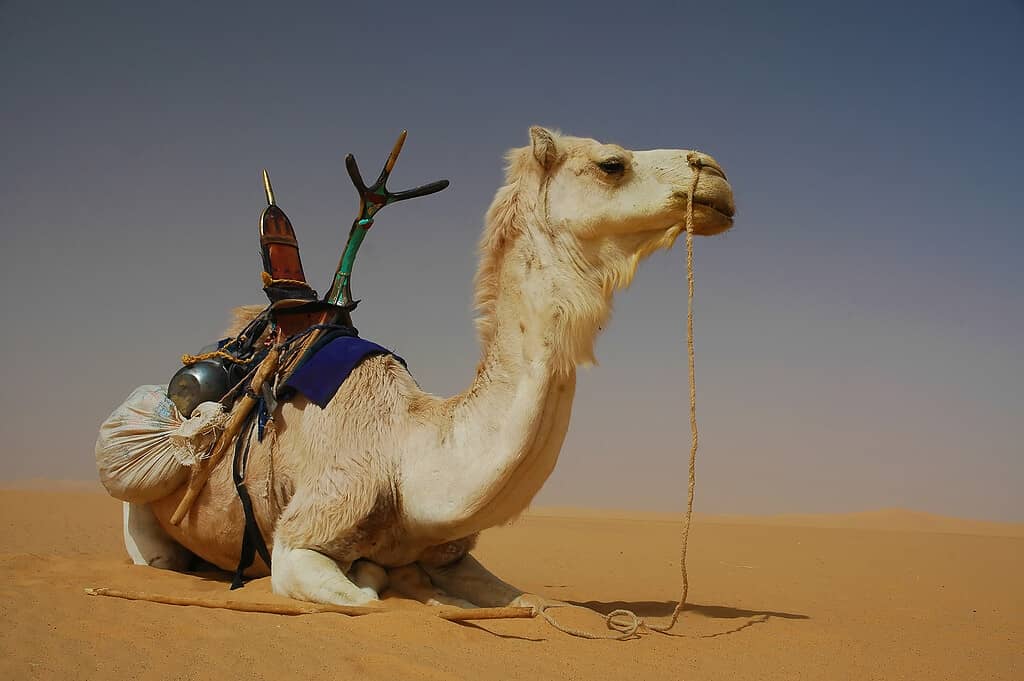
Dromedary camels only have one hump. It’s made from fat and used as energy when food is scarce.
©Trevor Kittelty/iStock via Getty Images
Like cows, camels don’t look dangerous. They don’t gnash large teeth, ambush prey, or wrestle antelope to the ground. In fact, vegetarian domesticated camels are pretty relaxed unless they are threatened, ill-treated, or defending their young. In that case, a kick and bite from a Saharan dromedary camel is painful and even life-threatening in certain circumstances.
Those recognizable humps store enough fat to enable miles of travel without sustenance, but they’ve adapted other moisture-saving tricks to withstand dry environments, too. For example, their poop is so dry it’s used to set campfires, and their urine resembles syrup. Camels can cope with a whopping 30% of their body weight in water loss.
9. Desert Crocodile

Desert crocodiles bromate in caves during the Saharan desert’s drought spells.
©Anton Ivanov/Shutterstock.com
Crocodiles in the Sahara Desert? Surely not! Yes! West African crocodiles, also called desert or sacred crocodiles, inhabit caves and burrows near permanent oases called gueltas. In periods of drought, they fall into a torpor until the great rains arrive to refill water holes.
West African crocs are rarer than Nile crocodiles that also inhabit the Sahara desert. Both species are dangerous, but the Nile crocodile is known for its ferocious nature.
Nile crocs are the largest water predators in Africa. Adult males grow to an epic 16.5 feet long and eat anything they can get hold of in permanent gueltas and seasonal floodplains. Their tenacity and strength are both terrible and incredible in equal measure.
Both Saharan crocodile species ambush drinking animals. Chiefly, this is gazelle, wildebeest, and antelope, but any animal is fair game to these dangerous crocs.
10. Spitting Cobra
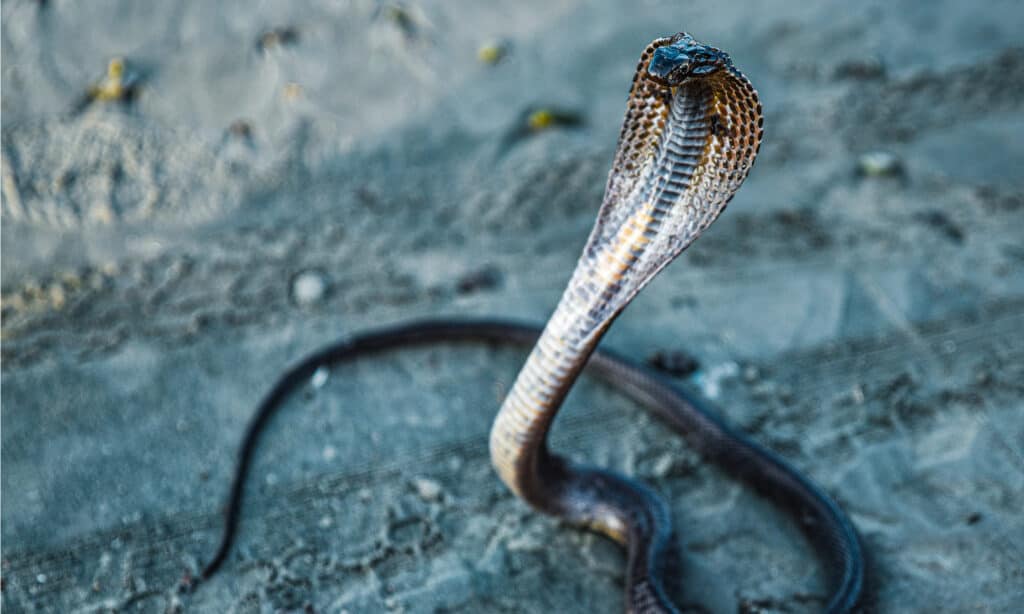
Spitting cobra venom can cause blindness.
©Syed Usman Zaidi/Shutterstock.com
Spitting cobras inhabit desert sands, caves, and rocky, arid areas of the Sahara. They reach three to four feet long and hunt out rodents, lizards, and birds at night.
Incredibly, spitting cobras can eject venom from up to ten feet away, aiming at their prey’s eyes. Although the venom doesn’t badly affect mammal skin, it causes blindness. Spitting cobras eject venom over distance as a defense mechanism, which experts think evolved against stampeding gazelles. To capture prey, they inject venom via lethal fangs instead.
Spitting cobras are less common than sidewinding snakes in the Sahara, but they’re dangerous and not something to spend time with.
11. Spinosaurus

112 million years ago, Spinosaurus lived in today’s Sahara Desert.
©Noiel/Shutterstock.com
That’s some of the most dangerous animals lurking in the Sahara desert, but all of them pale into insignificance when we consider ancient Saharan animals.
112 million years ago, deadly Spinosaurus lived in water that eventually dissipated into the Sahara desert. Paleontologists recently uncovered 1,200 Spinosaurus teeth from an ancient river bed in Morocco. They estimate the Spino was an epic 49 feet long and weighed six tons.
Even the brutal Nile crocodile couldn’t take that beast on!
The photo featured at the top of this post is © skander zarrad/ via Getty Images
Thank you for reading! Have some feedback for us? Contact the AZ Animals editorial team.






